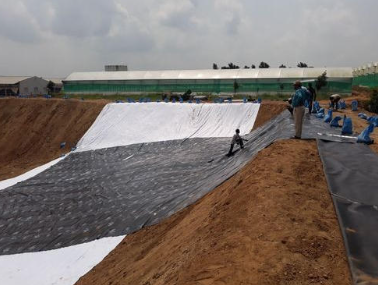- Understanding the Role of Geomembrane Liners in Waste Management
- Innovations in Geomembrane Liners for Water Management
- Geomembrane Liners: A Comprehensive Guide
- The Future of Geomembrane Liners in Civil Engineering
- Geomembrane Liners: Enhancing Landfill Stability
Manager:
WhatsApp:+86 177 0135 2670
Tel:+86 177 0135 2670
Email:marketing@okorder.com
Address:3rd Floor, No.2 Building, No.1 Sanlihe Road
What is a geomembrane for canal lining?
Canal lining is a crucial aspect of water management and conservation, especially in regions where water scarcity is a pressing issue. Geomembranes play a pivotal role in this process, providing impermeable barriers that prevent water seepage and enhance the efficiency of water conveyance systems. Among the various types of geomembranes used for canal lining, composite geomembranes and high-density polyethylene (HDPE) geomembranes stand out for their durability, flexibility, and effectiveness. Let's delve deeper into understanding these essential components of modern canal lining systems.

Understanding Geomembranes
Geomembranes are synthetic liners manufactured from polymers such as polyethylene, polypropylene, or PVC (polyvinyl chloride). These liners are engineered to withstand harsh environmental conditions and provide long-term containment solutions for various applications, including landfills, ponds, reservoirs, and canals. In canal lining, geomembranes serve as impermeable barriers that prevent water from seeping into the surrounding soil, thus conserving water resources and minimizing environmental impact.
Composite Geomembranes: A Versatile Solution
Composite geomembranes combine different materials to leverage the strengths of each component, resulting in a versatile and high-performance liner. Typically, a composite geomembrane consists of multiple layers, with each layer serving a specific purpose. These layers may include Geotextiles, geonet drainage layers, and impermeable membranes such as HDPE or PVC.
One of the primary advantages of composite geomembranes is their enhanced puncture resistance and tear strength. By incorporating geotextiles or geonets into the design, composite geomembranes can withstand external forces and terrain variations, making them ideal for challenging canal lining applications. Additionally, composite geomembranes offer improved interface friction characteristics, ensuring stability and adherence to the canal bed during installation.
High-Density Polyethylene (HDPE) Geomembranes: Unmatched Durability
hdpe Geomembranes are renowned for their exceptional durability, chemical resistance, and flexibility. Manufactured from high-density polyethylene resins, these geomembranes exhibit superior tensile strength and puncture resistance, making them suitable for demanding canal lining projects. HDPE geomembranes are available in various thicknesses, allowing engineers to tailor the liner's specifications to meet specific design requirements.
One of the key advantages of HDPE geomembranes is their resistance to ultraviolet (UV) radiation and environmental degradation. Unlike some other geomembrane materials, HDPE maintains its structural integrity when exposed to sunlight and harsh weather conditions, ensuring long-term performance and reliability in canal lining applications. Additionally, HDPE geomembranes are resistant to chemical corrosion, making them suitable for containment of water with varying pH levels and chemical compositions.
Installation Considerations
Proper installation is crucial to the effectiveness and longevity of geomembrane canal linings. Both composite geomembranes and HDPE geomembranes require meticulous attention to detail during installation to ensure seamless integration with the canal structure and optimal performance.
During installation, the canal bed should be properly prepared to remove any debris, sharp objects, or uneven surfaces that could potentially damage the geomembrane. Depending on site conditions, geotextile underlayment may be used to provide additional protection and cushioning for the geomembrane.
The geomembrane should be carefully unrolled and positioned in the canal, taking care to minimize wrinkles, folds, and overlaps. Seams and joints must be securely welded or bonded to create continuous, watertight seals. Quality control measures such as leak testing and geomembrane integrity assessments should be conducted to verify the effectiveness of the installation before water is introduced into the canal.

Conclusion
In conclusion, geomembranes play a vital role in canal lining applications, providing impermeable barriers that enhance water conservation and management efforts. Composite geomembranes and high-density polyethylene (HDPE) geomembranes offer versatile and durable solutions for canal lining projects, with each type possessing unique characteristics and advantages.
Composite geomembranes, with their multi-layered construction and enhanced puncture resistance, excel in challenging terrain and demanding environments. High-density polyethylene (HDPE) geomembranes, prized for their durability and chemical resistance, offer unmatched longevity and reliability in canal lining applications.
Regardless of the geomembrane type selected, proper installation and quality control are essential to ensuring optimal performance and longevity. By leveraging the benefits of composite geomembranes or HDPE geomembranes, engineers and water management professionals can enhance the efficiency and sustainability of canal lining projects, contributing to the effective utilization of water resources for generations to come."
-
2024-06-13Geomembrane is not plastic cloth






